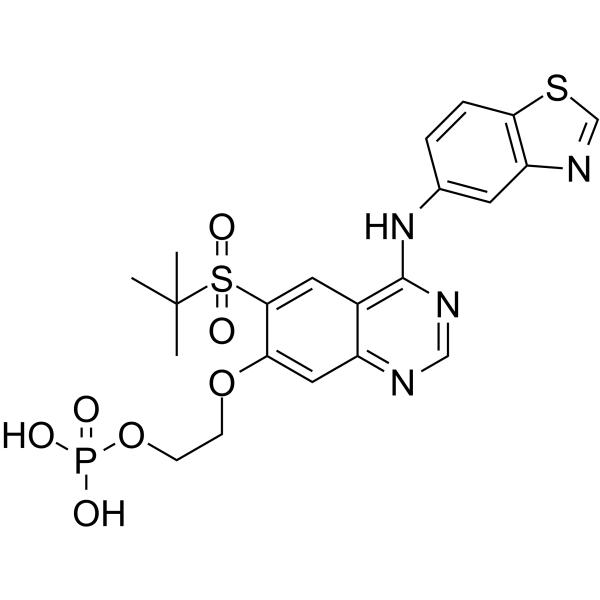
GSK2983559 free acid
CAS No. 1579965-12-0
GSK2983559 free acid ( —— )
产品货号. M26238 CAS No. 1579965-12-0
GSK2983559 free Acid 是一种有效的选择性受体相互作用蛋白 2 (RIP2) 抑制剂。
纯度: >98% (HPLC)
 COA
COA
 Datasheet
Datasheet
 HNMR
HNMR
 HPLC
HPLC
 MSDS
MSDS
 Handing Instructions
Handing Instructions
| 规格 | 价格/人民币 | 库存 | 数量 |
| 5MG | ¥786 | 有现货 |


|
| 10MG | ¥1215 | 有现货 |


|
| 25MG | ¥2033 | 有现货 |


|
| 50MG | ¥3038 | 有现货 |


|
| 100MG | ¥4560 | 有现货 |


|
| 200MG | 获取报价 | 有现货 |


|
| 500MG | 获取报价 | 有现货 |


|
| 1G | 获取报价 | 有现货 |


|
生物学信息
-
产品名称GSK2983559 free acid
-
注意事项本公司产品仅用于科研实验,不得用于人体或动物的临床与诊断
-
产品简述GSK2983559 free Acid 是一种有效的选择性受体相互作用蛋白 2 (RIP2) 抑制剂。
-
产品描述GSK2983559 free acid is an effective and selective inhibitor of receptor-interacting protein 2 (RIP2). GSK2983559 free acid shows excellent activity in blocking many proinflammatory cytokine responses in human inflammatory bowel disease explant samples.
-
体外实验GSK2983559 (1-1024 nM; 2 h) blocks MDP-induced IL-8 in THP-1 cells. Cell Viability Assay Cell Line:THP-1 cells Concentration:1-1024 nM Incubation Time:2 hours Result:Inhibited IL-8 production with an IC50 of 1.34 nM.
-
体内实验GSK2983559 (oral gavage; 3 and 10 mg/kg; once) inhibits effectively MDP-induced IL-6 in mouse. Animal Model:C57BL/6 mice (female) injected with MDP (100 μg) Dosage:3 and 10 mg/kg Administration:Oral gavage; 3 and 10 mg/kg; once Result:Suppressed serum IL-6 levels in a dose-dependent manner.
-
同义词——
-
通路Others
-
靶点Other Targets
-
受体leucyl-tRNA synthetase| Ras-related GTP-binding protein D (RagD)
-
研究领域——
-
适应症——
化学信息
-
CAS Number1579965-12-0
-
分子量538.53
-
分子式C21H23N4O7PS2
-
纯度>98% (HPLC)
-
溶解度In Vitro:?DMSO : 5 mg/mL (9.28 mM)
-
SMILESCC(C)(C)S(=O)(=O)c1cc2c(Nc3ccc4scnc4c3)ncnc2cc1OCCOP(O)(O)=O
-
化学全称——
运输与储存
-
储存条件(-20℃)
-
运输条件With Ice Pack
-
稳定性≥ 2 years
参考文献
1.Jong Hyun Kim, et al. Control of leucine-dependent mTORC1 pathway through chemical intervention of leucyl-tRNA synthetase and RagD interaction. Nat Commun. 2017 Sep 29;8(1):732.
产品手册




关联产品
-
Boc-NH-PEG12-CH2CH2C...
Boc-NH-PEG12-CH2CH2COOH 是一种基于 PEG 的 PROTAC 连接体,可用于 PROTAC 的合成。
-
Bovine Pineal Antire...
Threonyl-seryl-lysine 是一种牛松果体抗生殖三肽,具有抗促性腺激素活性。Threonyl-seryl-lysine 在 LHRH 2-5 位点与促黄体激素释放激素 (LHRH) 结合。
-
(5S,6S,7S,8R)-8-Chlo...
8-Chloro-2-(2-phenylethyl)-5,6,7-trihydroxy-5,6,7,8-tetrahydrochromone, a chromone derivative, is present in the methanol extract obtained from withered wood of Aquilaria sinensis.



 021-51111890
021-51111890 购物车()
购物车()
 sales@molnova.cn
sales@molnova.cn







